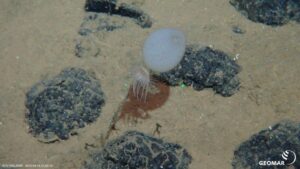Lodgers on manganese nodules

Sponge of the species Hyalonema obtusum in the Clarion-Clipperton Zone. Amphipods and cnidarians grow on the stalk of the sponge, while a sea cucumber sits at its foot.
GEOMAR, ROV-Team
Sponges promote a high diversity…
Deep down in the ocean, valuable raw materials are stored, such as nodules of manganese, iron, cobalt and copper. The resources from these nodules could help meeting our increasing demand for rare metals. However, in addition to the nodules, there is another treasure down there: A complex ecosystem that we still barely know and understand. Researchers from Bremen and the Netherlands have now discovered that sponges, which like to settle on the metallic nodules, also provide a home for many other animals. Without the nodules, species richness in these deep-sea regions would be significantly lower, the researchers report in the journal Scientific Reports.

Sponge of the species Hyalonema obtusum with anemones attached to its stalk. The sponge itself is attached by the stalk to a polymetallic nodule in the Clarion-Clipperton Zone.
GEOMAR, ROV-Team
Polymetallic nodules and crusts cover many thousands of square kilometres of the world’s deep-sea floor. They contain valuable metals and rare earth elements and are therefore of great economic interest. To date, there is no market-ready technology for deep-seabed mining. But it is already clear that interventions in the seabed have a massive and lasting impact on the areas affected. This is also confirmed by a study now published by Tanja Stratmann from the Max Planck Institute for Marine Microbiology in Bremen, Germany, and researchers from the Senckenberg am Meer Institute in Wilhelmshaven, Germany, and the Dutch research institute NIOZ.
In their study, Stratmann and her colleagues used data from a variety of existing surveys as well as deep seafloor imagery from two regions of the Pacific Ocean that are rich in manganese nodules. Using these data, they created a model of interactions in these regions.
“We discovered that stalked sponges are often attached to the polymetallic nodules,” Stratmann explained. The sponges use the hard nodules amid the muddy deep-sea environment as the only available hard substrate. With their stalks, they anchor themselves to the nodule while their main body protrudes into the water to filter tiny particles from it. Moreover, the sponges themselves provide a habitat for other animals, such as small worms, crabs and clams. “Our models predict the following: If the nodules are removed, the sponges will also disappear, and with them the associated fauna,” Stratmann added. “This reduces the number of animal species and links in the food web. Without the nodules, the food web in the deep sea becomes simpler and less divers.”
Stratmann and her colleagues examined two nodule-rich regions in the Pacific Ocean, the Clarion-Clipperton Zone and the Peru Basin. In both regions, a modelled removal of the nodules massively disturbed the ecosystem. This primarily resulted from so-called non-trophic interactions between different animals – those that do not revolve around “eat or be eaten”. These include interactions between the sponges and the animals that live on them, as well as between the sponge inhabitants themselves. In the Clarion-Clipperton Zone in particular, more than half of the deep-sea inhabitants depend on the nodules in one way or another.
Removal of the nodules and thus the sponges, as would be the case through deep-sea mining, would trigger a cascade of negative effects on the ecosystem. Rapid recovery is unlikely because the nodules take millions of years to grow to substantial size, and the deep-sea ecosystem regenerates very slowly.
Wissenschaftliche Ansprechpartner:
Dr. Tanja Stratmann
Max Planck Institute for Marine Microbiology, Bremen, Germany
Phone: +49 421 2028-9840
E-Mail: tstratma@mpi-bremen.de
Originalpublikation:
Tanja Stratmann, Karline Soetaert, Daniel Kersken, Dick van Oevelen (2021): Polymetallic nodules are essential for food-web integrity of a prospective deep-seabed mining area in Pacific abyssal plains. Scientific Reports (June 10, 2021).
DOI: https://doi.org/10.1038/s41598-021-91703-4
Weitere Informationen:
Media Contact
All latest news from the category: Life Sciences and Chemistry
Articles and reports from the Life Sciences and chemistry area deal with applied and basic research into modern biology, chemistry and human medicine.
Valuable information can be found on a range of life sciences fields including bacteriology, biochemistry, bionics, bioinformatics, biophysics, biotechnology, genetics, geobotany, human biology, marine biology, microbiology, molecular biology, cellular biology, zoology, bioinorganic chemistry, microchemistry and environmental chemistry.
Newest articles

Innovative 3D printed scaffolds offer new hope for bone healing
Researchers at the Institute for Bioengineering of Catalonia have developed novel 3D printed PLA-CaP scaffolds that promote blood vessel formation, ensuring better healing and regeneration of bone tissue. Bone is…

The surprising role of gut infection in Alzheimer’s disease
ASU- and Banner Alzheimer’s Institute-led study implicates link between a common virus and the disease, which travels from the gut to the brain and may be a target for antiviral…

Molecular gardening: New enzymes discovered for protein modification pruning
How deubiquitinases USP53 and USP54 cleave long polyubiquitin chains and how the former is linked to liver disease in children. Deubiquitinases (DUBs) are enzymes used by cells to trim protein…



